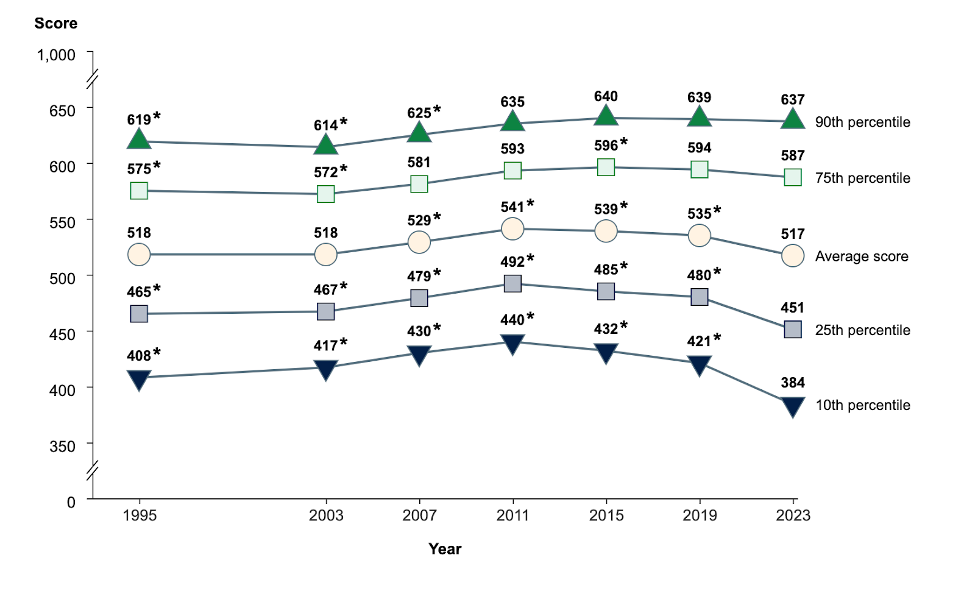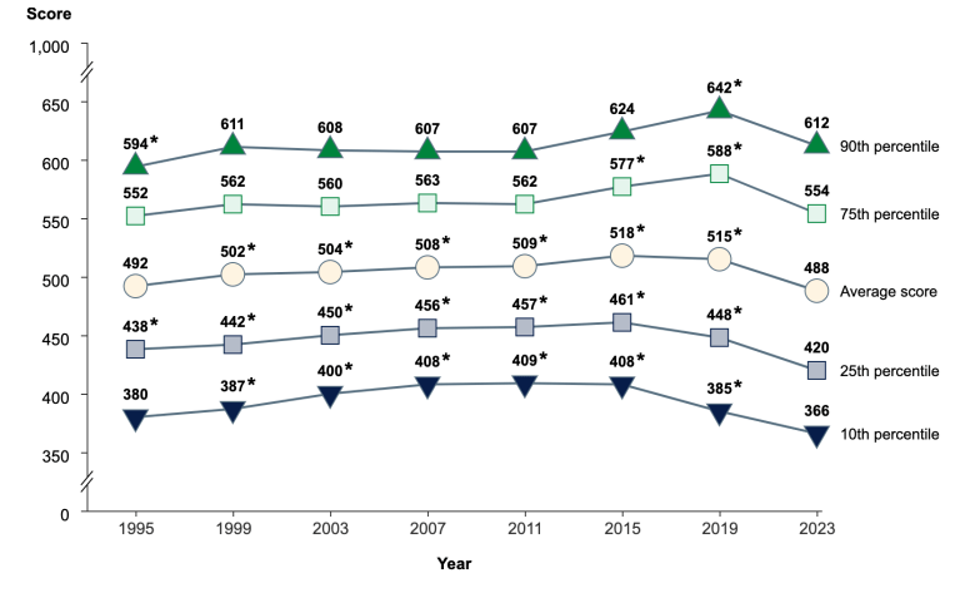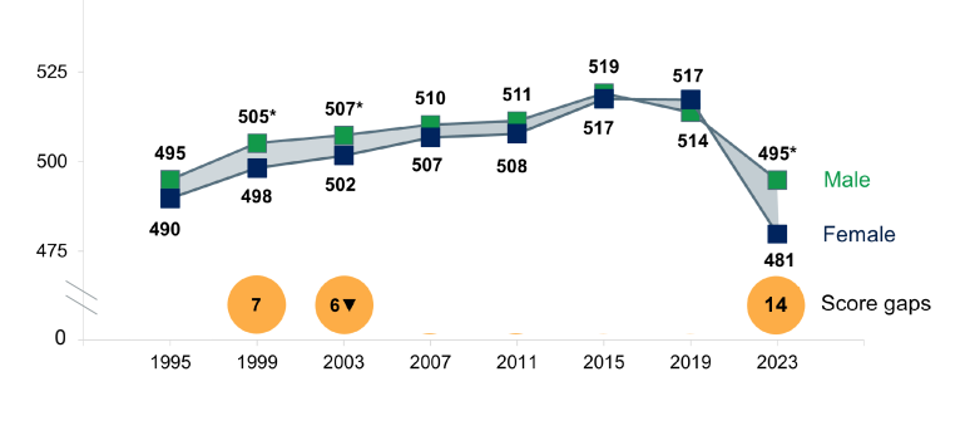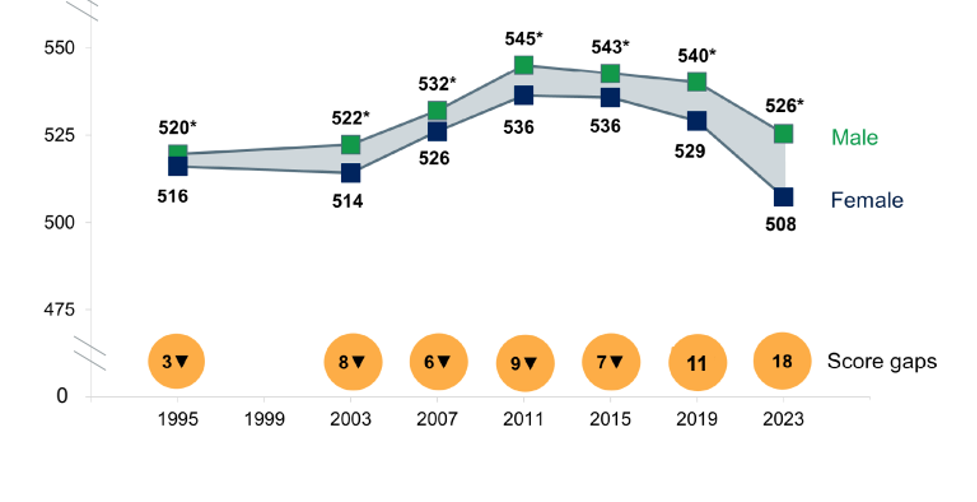“There’s a dwindling middle,” said Peggy Carr, commissioner of the National Center for Education Statistics, which is responsible for administering TIMSS in this country. Carr said that this group of students is being pulled down to the bottom – a pattern she is seeing across different tests and different subjects since the pandemic.
U.S. 4th-grade students on the TIMSS, 1995–2023, by student percentiles

Another way of understanding the shrinking middle is to see how few American children met basic math benchmarks. The test found that 13 percent of fourth graders could not add and subtract numbers with up to three digits, multiply and divide single-digit numbers and solve simple word problems. In 2019, the last time the test was administered, only 7 percent of fourth graders couldn’t handle these basics. In 2023, 32 percent of American fourth graders could not reach the second of four levels, called “intermediate,” which means they could not multiply three-digit numbers, add decimals or measure straight distances. In other words, a third of the fourth graders are struggling with grade-level math.
England, Germany, and Portugal all had more students hitting and surpassing these bottom two levels. (Click here to see how many fourth graders in each country reached the four levels: low, intermediate, high and advanced.)
“The dwindling of the middle is something that distinguishes the United States,” Carr said. Although the dwindling middle was most pronounced in fourth grade math, Carr said she noticed a similar decline in the skills of average U.S. adults, ages 16-65, on another 2023 international assessment, also released in this month.
The growing bifurcation of math skills between a small cluster at the top and growing cluster at the bottom, with a hollowing out of the middle, reflects the income distribution among U.S. households. “It looks like society,” said Goldhaber, a labor economist who worries that the academic losses triggered by the pandemic will make it harder for many young Americans to earn a good living. “They predict greater inequality in the future,” he said.
The math skills of even the highest scoring eighth graders have deteriorated

The math story with eighth graders is different from that of fourth graders. Achievement gaps between the bottom and the top scoring eighth graders have not widened. But the math scores of top students fell dramatically, 50 percent more than those at the bottom.
It’s not clear what’s behind the decline.
These eighth graders were in fifth grade when the pandemic hit in the spring of 2020. Despite tutoring and extra help at home, many students at the top 90th percentile appear not to have mastered middle school math skills as well as previous high-scoring eighth graders.
These results show the importance of math instruction at school as children get older, and how hard it is for even affluent families to make up for missed classroom time.
The gender gap re-emerges
Historically, American boys test better than girls in math. That gender gap disappeared in 2015 among eighth graders. But as scores plummeted, the gender gap reappeared in 2023. The gender gap never disappeared in fourth grade math, but in 2023, boys outscored girls by the widest margin ever.
Boys once again outpace girls in eighth grade math

An historic boy-girl gap in fourth grade math

‘Crazy’ patterns around the world
William Schmidt, a professor at Michigan State University, has studied international assessments for decades and has analyzed math curriculum around the world. He called the 2023 TIMSS results the “craziest” he has ever seen and said it is difficult to make sense of the mixed results. Some high-performing nations fell considerably yet remained at the top. Meanwhile, students in Turkey, which had never been a high-performing nation, suddenly rose to the upper tier. It will take time to sort out what that means. (Here are the international rankings for fourth grade and eighth grade math.)
Students in Sweden, which kept schools open during the pandemic, posted sharply higher math scores between 2019 and 2023. Their fourth graders hit a record. Still, analysts were unable to tell if shorter school closures were consistently linked to greater math gains. Sometimes, scores moved in opposite directions within the same country. For example, English fourth graders slipped while the country’s eighth graders improved. Covid closures were similar for both groups of students. Schmidt says it will take more time for researchers to gather this data and analyze it. (Here are the historical math scores, from 1995 to 2023, for each nation among fourth and eighth graders.)
Calculating the Covid effect
Another puzzle is how much of the decline in U.S. math scores to attribute to Covid and how much to attribute to other problems in American math education. Notably, math scores for U.S. fourth graders have been declining since 2011. Eighth graders have been posting lower math scores since 2015. They might well have continued declining between 2019 and 2023 had the pandemic never happened.
Reasons to hope
It is discouraging that the United States consistently ranks far behind the top 10 nations in math. (On the 2023 TIMSS, U.S. eighth graders ranked 22nd out of 44 countries and sub-national regions.)
Still, there are 360,000 American eighth graders in the top 10 percent who score at the most advanced of four levels. Mere average students in top-performing Singapore do just as well, but there are only 33,000 eighth graders in total in the city-state, according to Tom Loveless, an independent researcher who studies international assessments. Some of these advanced U.S. students may eventually develop the skills to cure cancer or find a cost-effective alternative to fossil fuels. Some will start companies and propel the American economy.
“One lesson from this is the sheer size of the United States makes up for a lot,” said Loveless. “We are producing 360,000 kids every year going into high school, and they know a tremendous amount of math.”
Another potential bright spot is that this TIMSS test was administered in the spring of 2023, a year and a half ago. Since then, several 2024 state tests show that students are rebounding, even if only by a small amount. Scores from the spring of 2024 are up in New York, Florida and California. “Forty years from now, we might see these TIMSS scores as the bottom, representing the full impact of the pandemic,” said Loveless. “We might have progress from here on out.”
If there is a rebound, we should be able to detect it on the 2024 National Assessment of Educational Progress (NAEP) that was administered earlier this year. Those scores are expected to be released in early 2025. I’ll be watching for them.
Contact staff writer Jill Barshay at 212-678-3595 or barshay@hechingerreport.org.




